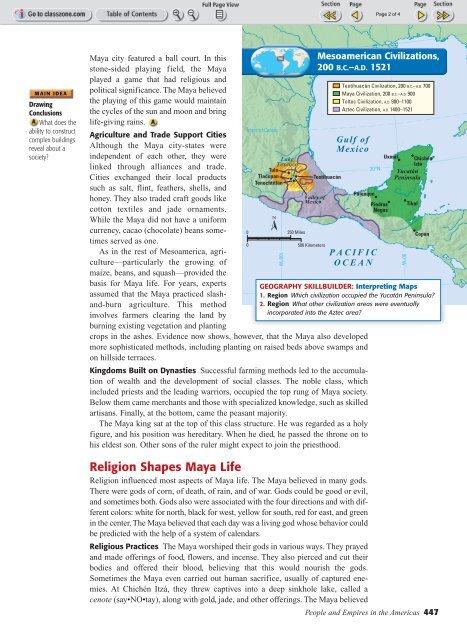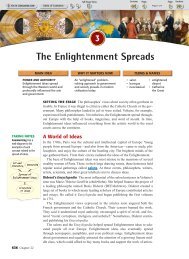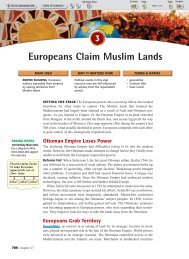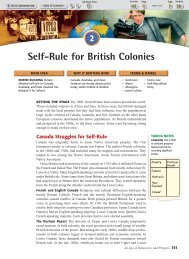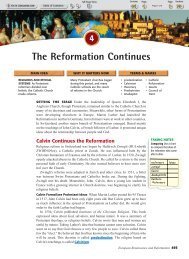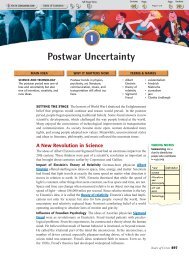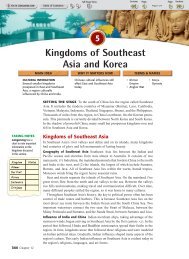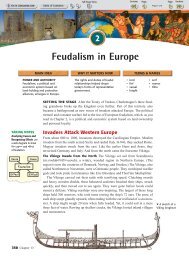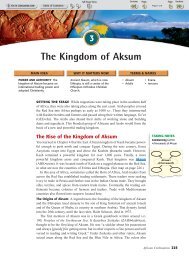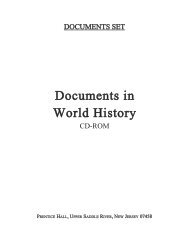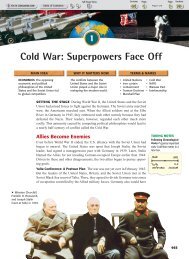Ch 16 Sec 2
Ch 16 Sec 2
Ch 16 Sec 2
- No tags were found...
You also want an ePaper? Increase the reach of your titles
YUMPU automatically turns print PDFs into web optimized ePapers that Google loves.
90°WDrawingConclusionsWhat does theability to constructcomplex buildingsreveal about asociety?Maya city featured a ball court. In thisstone-sided playing field, the Mayaplayed a game that had religious andpolitical significance. The Maya believedthe playing of this game would maintainthe cycles of the sun and moon and bringlife-giving rains.Agriculture and Trade Support CitiesAlthough the Maya city-states wereindependent of each other, they werelinked through alliances and trade.Cities exchanged their local productssuch as salt, flint, feathers, shells, andhoney. They also traded craft goods likecotton textiles and jade ornaments.While the Maya did not have a uniformcurrency, cacao (chocolate) beans sometimesserved as one.As in the rest of Mesoamerica, agriculture—particularlythe growing ofmaize, beans, and squash—provided thebasis for Maya life. For years, expertsassumed that the Maya practiced slashand-burnagriculture. This methodinvolves farmers clearing the land byburning existing vegetation and plantingTropic of CancerLakeTexcocoTulaTlacopanTenochtitlánTeotihuacánValley ofMexicoGulf ofMexicoPACIFICOCEANcrops in the ashes. Evidence now shows, however, that the Maya also developedmore sophisticated methods, including planting on raised beds above swamps andon hillside terraces.Kingdoms Built on Dynasties Successful farming methods led to the accumulationof wealth and the development of social classes. The noble class, whichincluded priests and the leading warriors, occupied the top rung of Maya society.Below them came merchants and those with specialized knowledge, such as skilledartisans. Finally, at the bottom, came the peasant majority.The Maya king sat at the top of this class structure. He was regarded as a holyfigure, and his position was hereditary. When he died, he passed the throne on tohis eldest son. Other sons of the ruler might expect to join the priesthood.00100°W250 Miles500 KilometersMesoamerican Civilizations,200 B.C.–A.D. 1521Teotihuacán Civilization, 200 B.C.–A.D. 700Maya Civilization, 200 B.C.–A.D. 900Toltec Civilization, A.D. 900–1100Aztec Civilization, A.D. 1400–1521Palenque20°NPiedrasNegasUxmal <strong>Ch</strong>ichénIztáYucatánPeninsulaTikalCopánGEOGRAPHY SKILLBUILDER: Interpreting Maps1. Region Which civilization occupied the Yucatán Peninsula?2. Region What other civilization areas were eventuallyincorporated into the Aztec area?10°NReligion Shapes Maya LifeReligion influenced most aspects of Maya life. The Maya believed in many gods.There were gods of corn, of death, of rain, and of war. Gods could be good or evil,and sometimes both. Gods also were associated with the four directions and with differentcolors: white for north, black for west, yellow for south, red for east, and greenin the center. The Maya believed that each day was a living god whose behavior couldbe predicted with the help of a system of calendars.Religious Practices The Maya worshiped their gods in various ways. They prayedand made offerings of food, flowers, and incense. They also pierced and cut theirbodies and offered their blood, believing that this would nourish the gods.Sometimes the Maya even carried out human sacrifice, usually of captured enemies.At <strong>Ch</strong>ichén Itzá, they threw captives into a deep sinkhole lake, called acenote (say•NO•tay), along with gold, jade, and other offerings. The Maya believedPeople and Empires in the Americas 447


